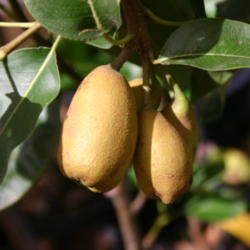
The codling moth ("codling" is an old name for a tiny apple) is a key pear and apple pest. The first adults appear at the time blossom petals fall. The adult insects lay eggs on young fruit, twigs, and leaves.
Controlling Codling MothTrichogramma wasp parasites will attack codling moth eggs and should be released about 10 days after any spray application. As the eggs start to hatch, the young caterpillars feed on the leaves for a few days. This is a good time to spray the tree with Bacillus thuringiensis (B.t.), which kills various leaf-chewing caterpillars. The larvae don't feed heavily on the leaves so you might consider adding one or two tablespoons of skim milk powder as a feeding enhancer to your spray mixture. After feeding on the leaves briefly, the worms enter the pears and eat for about a month. Although the fruits will be ruined that year, you should try to intercept the larvae after they leave the pear and descend the trunk to reach the soil, where they will finish their life cycle. A strip of burlap about 6 inches wide and covered with Tangle Trap (a sticky, trapping substance) can be tightly wrapped around the trunk and stapled together to form a formidable and usually lethal barrier. Several turns of corrugated cardboard around the trunk will entice many of the surviving larvae to spin their cocoons in it, and after a while you can simply remove the cardboard from the tree and burn it. If there are two or more generations of codling moths in your area, use the burlap strip as a monitor of caterpillar activity and destroy the cardboard about a month after the first larvae are caught in the trap.
Using Tangle TrapDon't apply Tangle Trap directly to the tree because it will injure the bark. Woodpeckers, particularly the downy and the hairy, will eat up to half of the larvae that overwinter in the orchard area. Hang a block of suet in the trees to attract woodpeckers. Scrape off old, flaky bark by using chicken wire like a bath towel to deny winter cover to the larvae and make the birds' job that much easier.
 Victory Seed Company has all the seeds you want for your best garden in 2024.
Victory Seed Company has all the seeds you want for your best garden in 2024.
For 25 years, the family-owned Victory Seed Company has provided the highest quality vegetable, herb and flower seeds to families across the country. We are passionate about providing you the best seeds available that give excellent germination, robust plants, and the harvest you want. With a catalog of over a thousand varieties, we have everything, and our prices are the kinds that we'd want to pay. We have hundreds of yesterday's heirloom vegetables, as well as today's award winning hybrid selections. Get to know us by visiting our website and browsing through our online vegetable seed catalog.
| 1. Meet the Asian Pears |
| 2. Pear Essentials |
| 3. Pear Varieties |
| 4. Pear Care |
| 5. Fireblight Disease on Pears |
| 6. Codling Moth on Pears ← you're on this article right now |
| 7. Harvesting Pears |
| 1. Meet the Asian Pears |
| 2. Pear Essentials |
| 3. Pear Varieties |
| 4. Pear Care |
| 5. Fireblight Disease on Pears |
| 6. Codling Moth on Pears ← you're on this article right now |
| 7. Harvesting Pears |